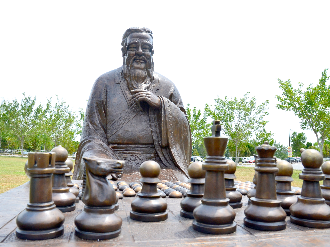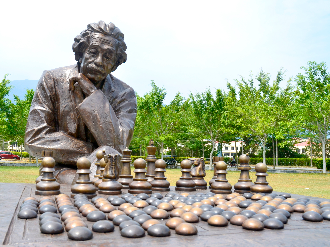

Bronze sculptures of Confucius and Einstein
The Universality of Learning and Thinking

The bronze sculptures of Confucius and Einstein are the pride of Universiti Tunku Abdul Rahman (UTAR). Located at the open space in front of the Heritage Hall Building in UTAR Kampar Campus, the sculptures symbolise the Universality of Learning and Thinking with the convergence of wisdoms from both the East and the West. The bronze sculptures of Confucius and Einstein depict two world renowned scholars from two different eras and cultures – an eminent philosopher from the East and a genius physicist from the West – seated facing each other pondering the next move in the mind-challenging game of chess. The Confucius statue measures 183 cm tall, 82 cm wide and 100 cm long and weighs 300 kg; while the Einstein statue measures 168 cm tall, 76 cm wide and 119 cm long and weighs 280 kg. Located in between the two statues is the chessboard that weights 120 kg, 76 cm tall, 91 cm wide and 91 cm long. The statues are seated on a 46 cm tall, 147 cm wide and 800 cm long pedestal. The inscription on the plaque depicts a profound message:
Universality of Learning and Thinking
Is it anachronism when the East meets the West at a tropical campus with over twenty centuries apart?
One is a sage in philosophy whose dialogue with his disciples has influenced generation after generation of people and shaped their outlook on life and their stand as mankind on earth. The other stands as a giant in science who has changed our view of time, space and the universe with his out-of-the-box ideas.
In front of us is but a mind game animated by an azure sky and a stunning landscape with its stretch of mountains, verdant display of foliage, reflective ponds reminiscent of a tin mining past, and activity of egrets and herons. Engaged in dialogue here is neither the Analects nor the Theory of Relativity. It is about how to learn.
Confucius: “He who learns but does not think is lost. He who thinks but does not learn is in great danger.”
Einstein: “All of science is nothing more than the refinement of everyday thinking.”
Without an endless exercise of thought and learning, how could both figures manage to stand tall and outshine their contemporaries and even posterity as models of faith and inspiration?
Universiti Tunku Abdul Rahman, amid the constant convergence of civilisations, strives to contribute to the sustainable development of the humanities, science and technology with an unrelenting mind on progressiveness, ethics and sparks of wisdom from the Orient and the Occident.
Acknowledgements UTAR would like to acknowledge the contribution of the following:
- Tan Sri Dato’ Hew See Tong, Advisor of UTAR Planning and Development Committee, for the donation of the bronze sculptures
- Mr Wang Chain Khiang, Faculty of Creative Industries, for the design of the bronze sculptures
- Prof Dr Lim Chooi Kwa, Institute of Chinese Studies, for the Chinese inscriptions
- Mr Luke Lim Kar Loke, Faculty of Arts and Social Science, for the translation of the Chinese inscriptions into English





